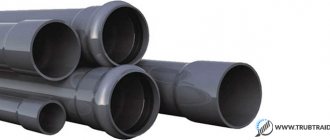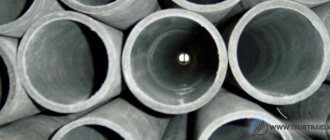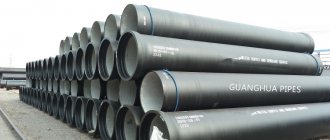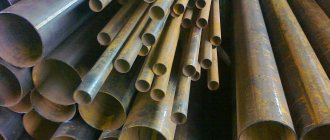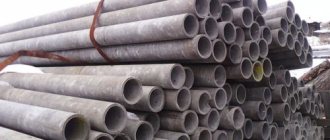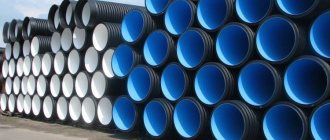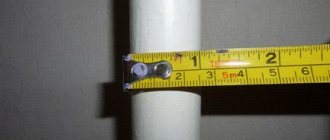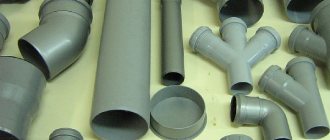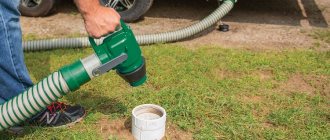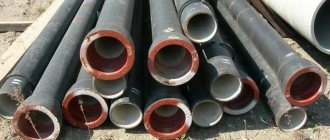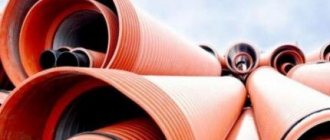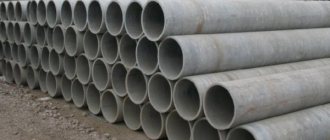Polyvinyl chloride (or simply PVC) pipes are the most suitable option for arranging a variety of systems: external or internal sewerage, electrical wiring, etc. This is due to their durability, resistance to corrosion and stray currents, resistance to the influence of organic and chemical substances, and the smoothness of the surface inside. There are a number of documents for PVC products that regulate their parameters: GOSTs 51613, 1898 and 52134, adopted from 2000 to 2003.
PVC pipes used for underground and above-ground sewerage systems are manufactured in accordance with GOSTs
Review of GOST standards for PVC pipes
Document 51613 of 2000 applies to pressure products made from unplasticized PVC. They can be used for water pipelines transporting drinking water, the temperature of which is 0-45 ºС, and other liquids, as well as gaseous substances.
Depending on the temperature of the medium, the pressure reduction coefficient is selected: 41-45 ºС – 0.64; 36-40 ºС – 0.70; 31-35 ºС – 0.78; 26-30 ºС – 0.88; up to 25 ºС – 1.00.
Note! GOST does not apply to electrical pipes.
Document 52134 of 2003 includes dimensions and requirements for fittings and pressure pipes made of various thermoplastics, including unplasticized and chlorinated PVC. A pipe manufactured according to standard 52134 does not contradict GOST 18599-2001. Such products can be used not only for water supply, but also for heating.
There are separate regulatory documents for PVC pipes for external sewerage. GOST 32413 of 2013 regulates the parameters of just such products and shaped elements for them.
Some provisions of GOST 18599
The main characteristics of polyethylene pressure pipes are defined in GOST 1898-2001. PVC sewer pipes are also classified as thermoplastic products.
Each pipe size, their wall thickness and other parameters are regulated by standards
Standard 18599 contains instructions for the use of pressure pipes made of polyethylene, their main dimensions, parameters, symbols and markings, technical requirements, test conditions and acceptance rules.
Plastic pipes are made from materials PE 63, PE 100, PE 32, PE 80. For each type, document 18599 defines the dimensions and maximum deviations of linear parameters. The value of the parameter for reducing the operating pressure (maximum) at a temperature of water transported through the pipeline to 40 ºС is given in the table.
Table 1
| Water temperature | Pressure reduction coefficient, *10-1 | ||
| PE (PE) 32 | PE (PE) 63 | PE (PE) 80 and PE (PE) 100 | |
| Up to 20 | 10,0 | 10,0 | 10,0 |
| 26-30 | 8,2 | 9,0 | 9,3 |
| 21-25 | 6,5 | 8,1 | 8,7 |
| 31-35 | 4,7 | 7,2 | 8,0 |
| 36-40 | 3,0 | 6,2 | 7,4 |
GOST 18599 allows the production of technical pipes from recycled materials.
What is uPVC
This type of polymer is obtained from raw materials consisting mainly of polyvinyl chloride, food resins and various additives. Moreover, polyvinyl chloride (PVC) is used without the plasticizers inherent in it under normal conditions. This is where the name of the material comes from – unplasticized polyvinyl chloride.
Decoding the abbreviation
Polyvinyl chloride is abbreviated in the Russian version as PVC, in the international version - PVC (English: polyvinyl chloride).
Accordingly, unplasticized, or as it is also called, unmodified polyvinyl chloride, is given the designation PVC-U. In international standards - PVC-U.
Types and sizes of products according to GOST 51613
According to GOST 51613-2000, PVC pipes are manufactured in the following types:
- with a socket for adhesive connection (RK);
- without bell;
- with a socket for connection with a sealing ring having a special cross-section (P).
One of the types of PVC sewer pipes are socketless products connected by couplings
Pipe sizes for 51613-2000 are presented in tables 1 and 2 (SDR/S/MOP, respectively, size ratio/series/maximum operating pressure in MPa).
table 2
| External diameter, *102mm | Wall thickness for PVC-U pipe 100, *10-1 mm | |||||
| SDR/S/MOP: 41/20/0,5 | SDR/S/MOP: 33/16/0,63 | SDR/S/MOP: 26/12,5/0,8 | SDR/S/MOP: 21/10/1,0 | SDR/S/MOP: 17/8/1,25 | SDR/S/MOP: 13,6/6,3/1,6 | |
| 0,1 | — | — | — | — | — | 15 |
| 0,12 | — | — | — | — | — | 15 |
| 0,16 | — | — | — | — | — | 15 |
| 0,20 | — | — | — | — | — | 15 |
| 0,25 | — | — | — | — | 15 | 19 |
| 0,32 | — | — | — | 16 | 19 | 24 |
| 0,40 | — | 15 | 16 | 19 | 24 | 30 |
| 0,50 | — | 16 | 20 | 24 | 30 | 37 |
| 0,63 | 16 | 20 | 25 | 30 | 38 | 47 |
| 0,75 | 19 | 23 | 29 | 36 | 45 | 56 |
| 0,90 | 22 | 28 | 35 | 43 | 54 | 67 |
Table 3
| External diameter, *102 mm | Wall thickness for PVC-U pipe 125 (100), *10-1 mm | |||||
| SDR/S/MOP: 41/20/0,63(0,5) | SDR/S/MOP: 33/16/0,8(0,63) | SDR/S/MOP: 26/12,5/1,0(0,8) | SDR/S/MOP: 21/10/1,25(1,0) | SDR/S/MO: 17/8/1,6(1,25) | SDR/S/MOP: 13,6/6,3/2,0(1,6) | |
| 1,10 | 27 | 34 | 42 | 53 | 66 | 81 |
| 1,25 | 31 | 39 | 48 | 60 | 74 | 92 |
| 1,40 | 35 | 43 | 54 | 67 | 83 | 103 |
| 1,60 | 40 | 49 | 62 | 77 | 95 | 118 |
| 1,80 | 44 | 55 | 69 | 86 | 107 | 133 |
| 2,00 | 49 | 62 | 77 | 96 | 119 | 147 |
| 2,25 | 55 | 69 | 86 | 108 | 134 | 166 |
| 2,50 | 62 | 77 | 96 | 119 | 148 | 184 |
| 2,80 | 69 | 86 | 107 | 134 | 166 | 206 |
| 3,15 | 77 | 97 | 121 | 150 | 187 | 232 |
Dimensions of sockets according to GOST 51613
The sockets for the sealing ring for connection must have the dimensions presented in the table, where a1 is the internal diameter of the socket (*10-1 mm), a2 is the internal diameter of the socket at the place where the ring is installed (*10-1 mm), e1 is the thickness of the socket wall (*10-1 mm), g1 – length of the socket to the groove for the ring (mm), g – length of the socket (*10-1 mm), a – chamfer angle, SDR/S, respectively, dimensional ratio/series.
Table 4
| Nominal outer diameter, *102 mm | a1 | a2 | e1 at SDR/S | g1 | g | A | |||||
| 41/20 | 33/16 | 26/12,5 | 21/10 | 17/8 | 13,6/6,3 | ||||||
| 0,63 | 636 | 800 | — | — | — | — | 42 | 52 | 13 | 995 | 6 |
| 0,75 | 756 | 939 | — | — | — | 40 | 50 | 62 | 14 | 1025 | 7 |
| 0,90 | 907 | 1107 | — | — | 39 | 47 | 59 | 74 | 15 | 1105 | 8 |
| 1,10 | 1108 | 1325 | — | 37 | 46 | 58 | 73 | 89 | 17 | 1160 | 10 |
| 1,25 | 1259 | 1484 | — | 43 | 53 | 66 | 81 | 101 | 19 | 1215 | 11 |
| 1,40 | 1409 | 1642 | 39 | 47 | 59 | 74 | 91 | 113 | 20 | 1270 | 12 |
| 1,60 | 1610 | 1860 | 44 | 54 | 68 | 85 | 105 | 130 | 22 | 1345 | 14 |
| 1,80 | 1811 | 2083 | 48 | 61 | 76 | 95 | 118 | 146 | 23 | 1405 | 16 |
| 2,00 | 2012 | 2289 | 54 | 68 | 85 | 106 | 131 | 162 | 25 | 1465 | 18 |
| 2,25 | 2264 | 2545 | 61 | 76 | 95 | 119 | 147 | 183 | 27 | 1540 | 20 |
| 2,50 | 2515 | 2819 | 68 | 85 | 106 | 131 | 163 | 202 | 29 | 1622 | 22 |
| 2,80 | 2816 | 3147 | 76 | 95 | 118 | 147 | 183 | 227 | 32 | 1720 | 24 |
| 3,15 | 3168 | 3513 | 85 | 107 | 133 | 165 | 206 | 225 | 35 | 1840 | 26 |
Sockets for adhesive joints according to 51613-2000 must correspond to the parameters in the table, where a1 is the internal diameter of the socket (*10-1 mm), g is the length of the socket (cm), a is the chamfer angle.
Table 5
| External diameter, *102 mm | g | a1 | A |
| 0,10 | 2,8 | 103 | 2 |
| 0,12 | 2,8 | 123 | 2 |
| 0,16 | 2,8 | 163 | 2 |
| 0,20 | 3,2 | 203 | 3 |
| 0,25 | 3,2 | 253 | 3 |
| 0,32 | 3,2 | 323 | 3 |
| 0,40 | 4,0 | 403 | 4 |
| 0,50 | 5,0 | 503 | 5 |
| 0,63 | 6,3 | 633 | 6 |
| 0,75 | 7,0 | 753 | 7 |
| 0,90 | 7,9 | 903 | 8 |
| 1,10 | 9,1 | 1103 | 10 |
| 1,25 | 10,0 | 1253 | 11 |
| 1,40 | 10,9 | 1404 | 12 |
| 1,60 | 12,1 | 1604 | 14 |
Requirements for PVC products according to 51613-2000
The basis for the manufacture of PVC pipes (GOST 14040) is suspension polyvinyl chloride, which has a K value of at least 67.
Both the internal and external surfaces of the pipes must be smooth; an O-ring must be present inside the socket
Surfaces inside and outside must be smooth with acceptable slight waviness and longitudinal stripes. The standard determines strength indicators at constant pressure inside the pipe. The corresponding values are given in the table.
Table 6
| Temperature, ºС | Initial stress, *10 MPa | Durability, h, no less |
| 20 | 4,2 | 1 |
| 20 | 3,5 | 100 |
| 60 (for PVC (1) 100) | 1,0 | 1 thousand |
| 60 (for PVC (1) 125) | 1,25 | 1 thousand |
GOST 51613-2000 for PVC sewerage (pressure) pipes defines the Charpy impact strength value. It is important that the number of destroyed samples is no more than 10%.
Note! After heating, the permissible change in length is no more than 5 percent.
Some other parameters of pipes that can be used for external as well as internal sewerage are given in the table.
Table 7
| Index | Meaning | Unit |
| Yield strength during stretching for products with a diameter of more than 0.12 * 102 mm | 49*103 | not less, kPa |
| Relative elongation at break for products with a diameter of more than 0.12 * 102 mm | 25 | % |
| Vicat softening point | 78 | no less, ºС |
| Opacity | 0,2 | not more, % |
Production Features
Scientists have created many varieties of polyethylene. In relation to polyethylene pipes for sewerage, three names are usually mentioned: low-pressure polyethylene (LDPE), high-pressure polyethylene (HDPE), and medium-pressure polyethylene (MPD).
The concept of “pressure” in this case describes the features of PE production. PE produced by low and medium pressure methods has approximately the same density and molecular weight. LDPE has lower density and greater ductility. The methods differ in the catalysts and temperatures used.
Parameters of pipes for sewerage and water supply according to GOST 52134
In accordance with GOST 52134-2003, pipes have dimensions depending on the series and SDR of the product. They are produced in the form of straight sections.
Pipes are produced in lengths determined by GOST, and in this form the products go on sale
The calculated mass must correspond to the values in GOST 51613 and 18599.
Table 8
| External diameter, *102 mm | Estimated weight of a meter of pipe at SDR/S, *10-1 kg | |||||
| 41/20 | 33/16 | 26/12,5 | 21/10 | 17/8 | 13,6/6,3 | |
| 0,1 | — | — | — | — | — | 0,63 |
| 0,12 | — | — | — | — | — | 0,78 |
| 0,16 | — | — | — | — | — | 1,08 |
| 0,20 | — | — | — | — | — | 1,38 |
| 0,25 | — | — | — | — | 1,75 | 2,13 |
| 0,32 | — | — | — | 2,40 | 2,78 | 3,44 |
| 0,40 | — | 2,87 | 3,04 | 3,51 | 4,37 | 5,35 |
| 0,50 | — | 3,83 | 4,74 | 5,54 | 6,80 | 8,12 |
| 0,63 | 4,86 | 6,03 | 7,31 | 8,69 | 10,6 | 12,9 |
| 0,75 | 6,75 | 8,14 | 9,98 | 12,2 | 15,0 | 18,2 |
| 0,90 | 9,45 | 11,7 | 14,4 | 17,5 | 21,5 | 26,1 |
| 1,10 | 13,9 | 17,3 | 21,1 | 26,2 | 32,0 | 38,6 |
| 1,25 | 18,2 | 22,3 | 27,2 | 33,4 | 40,8 | 49,7 |
| 1,40 | 22,8 | 27,7 | 34,3 | 41,9 | 51,1 | 62,3 |
| 1,60 | 29,8 | 35,8 | 44,9 | 54,8 | 66,7 | 81,2 |
| 1,80 | 36,7 | 45,3 | 55,9 | 68,9 | 84,3 | 103 |
| 2,00 | 45,0 | 56,6 | 69,3 | 85,3 | 104 | 126 |
| 2,25 | 57,0 | 70,5 | 87,0 | 108 | 132 | 160 |
| 2,50 | 71,3 | 87,4 | 108 | 132 | 162 | 198 |
| 2,80 | 88,3 | 109 | 134 | 166 | 203 | 247 |
| 3,15 | 111 | 138 | 171 | 209 | 257 | 314 |
At the same time, GOST takes the density of the material to be 1400 kg/m. The weight of type P sockets is given in the table.
Table 9
| External diameter, *102 mm | Estimated weight of sockets at SDR/S, *10-1kg | |||||
| 41/20 | 33/16 | 26/12,5 | 21/10 | 17/8 | 13,6/6,3 | |
| 0,63 | — | — | — | — | 1,40 | 1,71 |
| 0,75 | — | — | — | 1,63 | 2,01 | 2,46 |
| 0,90 | — | — | 2,03 | 2,43 | 3,02 | 3,73 |
| 1,10 | — | 2,44 | 3,01 | 2,69 | 4,68 | 5,63 |
| 1,25 | — | 3,32 | 4,06 | 5,01 | 6,09 | 7,48 |
| 1,40 | 3,50 | 4,20 | 5,23 | 6,43 | 7,91 | 9,68 |
| 1,60 | 4,74 | 5,78 | 7,22 | 8,95 | 10,9 | 13,3 |
| 1,80 | 6,05 | 7,64 | 9,45 | 11,7 | 14,4 | 17,5 |
| 2,00 | 7,79 | 9,75 | 12,1 | 14,9 | 18,3 | 22,2 |
| 2,25 | 10,3 | 12,7 | 15,8 | 19,6 | 23,9 | 29,3 |
| 2,50 | 13,4 | 16,6 | 20,6 | 25,2 | 30,9 | 37,8 |
| 2,80 | 17,7 | 22,0 | 27,1 | 33,4 | 41,1 | 50,2 |
| 3,15 | 23,6 | 29,5 | 36,4 | 44,8 | 55,2 | 67,4 |
Limit deviations according to standard 52134
The regulatory document, referring to GOST 18599-2001, for PVC sewer pipes defines such maximum diameter deviations and permissible ovality.
Table 10
| Nominal diameter outside, *102 mm | PVC unplasticized | PVC chlorinated | ||
| Ovality, *10—1mm | Maximum deviation (+), *10-1 mm | Ovality, *10-1 mm | Maximum deviation (+), *10-1 mm | |
| 0,1 | — | — | 12 | 2 |
| 0,12 | 12 | 3 | 12 | 3 |
| 0,16 | 12 | 3 | 12 | 3 |
| 0,20 | 12 | 3 | 12 | 3 |
| 0,25 | 12 | 3 | 12 | 3 |
| 0,32 | 13 | 3 | 13 | 3 |
| 0,40 | 14 | 3 | 14 | 3 |
| 0,50 | 14 | 3 | 14 | 3 |
| 0,63 | 15 | 3 | 15 | 3 |
| 0,75 | 16 | 3 | 16 | 3 |
| 0,90 | 18 | 3 | 18 | 3 |
| 1,10 | 22 | 4 | 22 | 4 |
| 1,25 | 25 | 4 | 25 | 4 |
| 1,40 | 28 | 5 | 28 | 5 |
| 1,60 | 32 | 5 | 32 | 5 |
| 1,80 | 36 | 6 | 36 | 6 |
| 2,00 | 40 | 6 | 40 | 6 |
| 2,25 | 45 | 7 | 45 | 7 |
| 2,50 | 50 | 8 | 50 | 8 |
| 2,80 | 68 | 9 | 68 | 9 |
| 3,15 | 76 | 10 | 76 | 10 |
| 3,55 | 86 | 11 | 86 | 11 |
| 4,00 | 96 | 12 | 96 | 12 |
| 4,50 | 108 | 14 | 108 | 14 |
| 5,00 | 120 | 15 | 120 | 15 |
| 5,60 | 135 | 17 | 135 | 17 |
| 6,30 | 152 | 19 | 152 | 19 |
| 7,10 | 171 | 20 | — | — |
| 8,00 | 192 | 20 | — | — |
| 9,00 | 216 | 20 | — | — |
| 10,00 | 240 | 20 | — | — |
GOST 52134 also lists the permissible deviations that pipe wall thicknesses may have. The values are given in the table.
Table 11
| Pipe wall thickness range, *10-1mm | Maximum deviation, *10-1 mm | |
| PVC unplasticized | PVC chlorinated | |
| 10-20 | 4 | 4 |
| 21-30 | 5 | 5 |
| 31-40 | 6 | 6 |
| 41-50 | 7 | 7 |
| 51-60 | 8 | 8 |
| 61-70 | 9 | 9 |
| 71-80 | 10 | 10 |
| 81-90 | 11 | 11 |
| 91-100 | 12 | 12 |
| 101-110 | 13 | 13 |
| 111-120 | 14 | 14 |
| 121-130 | 15 | 15 |
| 131-140 | 16 | 16 |
| 141-150 | 17 | 17 |
| 151-160 | 18 | 18 |
| 161-170 | 19 | 19 |
| 171-180 | 20 | 20 |
| 181-190 | 21 | 21 |
| 191-200 | 22 | 22 |
| 201-210 | 23 | 23 |
| 211-220 | 24 | 24 |
| 221-230 | 25 | 25 |
| 231-240 | 26 | 26 |
| 241-250 | 27 | 27 |
| 251-260 | 28 | 28 |
| 261-270 | 29 | 29 |
| 271-280 | 30 | 30 |
| 281-290 | 31 | 31 |
| 291-300 | 32 | 32 |
| 301-310 | 33 | — |
| 311-320 | 34 | — |
| 321-330 | 35 | — |
| 331-340 | 36 | — |
| 341-350 | 37 | — |
| 351-360 | 38 | — |
| 361-370 | 39 | — |
| 371-380 | 40 | — |
Designation of pipes and fittings according to GOST 52134
All regulatory documents (GOST 51613, 52134, 18599) provide rules for the symbolic designation of pipes. It usually includes the abbreviated name of PVC (UPVC 125 or UPVC 100), the type of socket, and the dimensional ratio.
Any type of pipe must be marked in accordance with the requirements of the standards; this data informs the buyer about the technical characteristics of the products
Numerical values of wall thickness and outer diameter are also given through a dash. In addition, the pipe has a designation for its purpose:
- household and drinking;
- technical
The designation of fittings made of various thermoplastics includes the name of the production material, the value of the minimum long-term strength, increased by 10 times, and the dimensional ratio. The dash indicates the nominal diameter (outer) of the pipe and its wall thickness that will be connected, the service class, and the nominal pressure expressed in MPa.
At the end of the product designation, the GOST according to which they are made is given.
Specifics of external and internal pipelines
The components of the internal sections of the system are gray in color. Their diameter ranges from 25 to 200 mm, but the most common are 50 and 110 mm. As a rule, all straight sections and fittings have a socket type connection for a rubber ring. This is the most convenient installation method, allowing you to quickly disassemble and redo the work if necessary.
The external components of the system are painted orange (red). They have thicker walls and are designed for increased mechanical loads. This is important as the networks are laid under roads or areas where heavy loads are moving. External pipes are larger in size because they typically receive waste from multiple internal lines.
The wall thickness depends on the purpose of the pipes. For internal areas it ranges from 1.8 mm. The external elements are designed for increased load, so their walls have a thickness of 3.6 mm. As the diameter increases, this figure increases proportionally. These values are only valid for non-pressure systems.
Everything useful about sewerage -
GidKanal | Yandex Zen
Safety requirements for PVC pipes
Pipes made of unplasticized PVC can be classified in the third hazard class, defined in GOST 12.1.005, as well as in the group of low-flammable products (GOST 12.1.044), the ignition temperature of which is not lower than 300 degrees.
When stored and used, such pipes are not capable of releasing toxic substances into the environment. When contacting them, the use of personal protective equipment is not required. The safety of the production process must meet the requirements of GOST 12.3.030.
Note! Sanitary standards allow the release of vinyl chloride in water during operation of drinking water pipes made of unplasticized PVC no more than 0.01 mg/l.
To prevent atmospheric pollution during production, the points of GOST 17.2.3.02 must be followed. Before putting into operation pipelines for utility and drinking purposes, they are washed with drinking water for more than 2 hours.
PVC pipes are also used to supply drinking water; in this case, the new pipeline must be washed after installation.
GOST 32413-2013
e) saddle outlet for adhesive connection (Figure 10).
For saddle bends, size L must be at least:
50 mm - for dn2 110;
60 mm - for dn2 125;
70 mm - for dn2 160;
80 mm - for dn2 200.
For saddle bends dni < 315 mm, the contact area with the pipe must be at least half the circle, and for cfni g 315 mm, the width of the lining a must be at least 80 mm.
The preferred nominal angle a for saddle bends is 45°. The nominal angle a can be selected from 87°30′ to 90°, when dn2/cfni ^ 2/3;
e) plug (Figure 11). The minimum length of the pipe end of the plug is M = Stach + 10 mm.
Other types and designs of fittings are permitted.
The installation length z of fittings must be specified by the manufacturer. The installation length z of fittings is not used for quality control.
The design and nomenclature of fittings must be established in the design and technical documentation of the manufacturer.
11
GOST 32413-2013
| tx | |
| 2L2n | 11P + X_ |
Figure 7 - Coupling
| Figure 8 — Transition pipe |
12
GOST 32413-2013
13
Advantages of PVC sewer pipes
GOSTs regulate the basic parameters and characteristics of PVC products. Such communications are the most acceptable option for arranging an external sewer network, since they can last up to half a century at a temperature of no more than 45 ºС. They also have high hygienic cleanliness and environmental safety.
Light weight and a variety of fittings ensure convenient transportation and quick installation. The installation of external sewerage is possible due to the pipe’s resistance to ultraviolet radiation, low temperatures and its low flammability.
When choosing a suitable PVC product, you should pay attention to such parameters as diameters, lengths and strength classes. In addition, it is important to be sure that PVC pipes for sewerage comply with GOST standards.
There are three hardness groups:
- Heavy (S), withstanding 8 thousand N/m2;
- Medium (N), withstanding 4 thousand N/m2;
- Lightweight (L), withstanding 2 thousand N/m2.
The first class is designated SN-8 and has the possibility of underground installation up to 8 m deep, the second - SN-4 - under areas with low traffic, the third - SN-2 can be located at shallow depths.
Advantages and disadvantages
The advantages of PVC pipes include:
- relatively low price;
- lack of reaction to ultraviolet light;
- smooth surface of the internal walls, preventing the formation of blockages;
- impossibility of corrosion;
- long service life (according to manufacturers, up to 50 years);
- mechanical strength of the pipes themselves and connecting elements;
- high assembly speed;
- light weight, ease of loading, transportation and storage;
The disadvantages of PVC pipes include:
- the material becomes brittle as the temperature drops. If assembly is carried out in the cold season, this point must be taken into account and act carefully;
- low sound insulation;
- inability to work with hot liquids;
- freezing of water in the cavity of the system leads to its destruction.
Another disadvantage is the high temperature expansion of the material. A socket assembly with a seal, which uses a rubber ring or special packing, allows compensation for changes in dimensions. An alternative option is polyethylene sewer pipes GOST 22689.2-89, which have lower thermal expansion.
Installation of external sewerage network
PVC pipes, GOST standards for which determine their parameters, can be used in internal and external wastewater networks. For the second option, products according to documents 51613-2000 and 52134 from 2003, equipped with an O-ring and a socket, are suitable.
To lay an external sewer network, it is necessary to dig a trench and prepare it for laying pipes
The laying of PVC pipes for the external network begins from the foundation. The place where the part enters the socket is lubricated, and it is inserted into it until it stops. The pipeline is insulated with a special heat-insulating material.
Note! When laying, a slope of 0.02 m per meter of PVC pipe length is maintained.
Inspection wells are installed every 15 meters. At the final stages, the slope of the system is checked and it is sprinkled layer by layer with sand, which is lightly compacted on the sides. Next, the trench is filled with soil. The entire sewerage pipeline is laid to a septic tank or waste well.
Internal PVC sewerage
The internal sewerage system is designed to remove wastewater from residential premises and buildings. It consists of pipes, branch lines, outlets and risers. For this reason, installation work is carried out during the construction phase.
Such sewerage is used in permanent or short-term mode. During installation, gluing and socket joints are used. Mounting clamps prevent slipping during installation. The following distances must be observed when fixing elements:
- one to two meters for vertical lines;
- 10 diameters of communications for horizontal sections;
- between sewer pipes and walls - at least 4 mm.
Using two 45-degree turns rather than one 90 will help reduce the noise level. It is also important to avoid burrs on the ends of the products after cutting, since the presence of roughness and protrusions contributes to the accumulation of unwanted deposits in such places and the formation of blockages.
Internal sewerage made from PVC pipes is one of the most common communication options in modern homes.
Tips on how to choose
Almost all sewerage pipes are made from inexpensive and fairly durable HDPE. The choice of a specific type of product and installation method depends primarily on the conditions of laying the sewerage system - depth, pressure; its type - pressure or non-pressure. For pressure pipes, long polyethylene pipes are always chosen and installed like water supply pipelines.
For conventional non-pressure pipes, socket pipes and fittings are used. For very deep sewers, in places with the risk of landslides, land subsidence, in regions with increased seismic hazard, a two-layer corrugation is used.
The diameters for internal wiring are described above. For external systems in private houses, pipelines with a diameter of 110 mm are used; for risers and horizontal sections in a private house, 110 mm is also sufficient; to collect wastewater from several wells, communications with a diameter of 160 mm or more are laid. Large diameter pipelines are used for municipal sewers.
Corrugated electrical PVC pipes
Basic documents for PVC pipes for electrical wiring - GOSTs. Such products are manufactured in accordance with GOST 51613, their installation is determined by GOST 30244.
Note! Corrugated products are intended for laying electrical wiring in floors, ceilings, walls and openly in warehouses and industrial premises.
Structurally, such communications have 2 layers - the outer corrugated and the inner - extremely smooth. Thanks to this structure, they have significant annular rigidity, a good degree of protection during thermal or mechanical impacts, and increased flexibility.
Reinforced corrugated products are made of a spiral frame, which is filled with soft polyvinyl chloride. They are most often used to connect control panels with power panels and to combine process equipment operating under high vibrations.
Wall thickness
The strength of the product, its ability to withstand soil loads during underground installation, and increased pressure in the channel depend on this parameter. Therefore, in external sewerage, bends with wall thicknesses from 3.2 mm to 24.5 mm are used
In addition, multilayer pipes of various types are produced:
- Type A - with smooth external and internal walls, between which either a foamed polymer layer or hollow profiles are placed.
- Type B - with a smooth base and an outer profiled layer consisting of annular ribs or profiles of various shapes.
Parameters of corrugated PVC pipes
GOST 14254 regulates the degree of protection that electrical pipes must provide. Corrugated PVC products meet all the requirements of this document. They are made of a material characterized by its ability to self-extinguish.
PVC corrugations are often used for laying electrical wiring in an open way and protecting it from pressure during hidden installation.
Installation can be carried out at temperatures of -5 – +60 degrees. To facilitate placing the electrical cable inside the pipe, the latter can be equipped with a broach. Heavy-duty products have increased strength and can be laid under a cement screed. Corrugated pipes are packaged in coils of 100, 50, 25, 20 and 15 meters, which can be stored for up to two years.
Such products make it possible to install the system in a space with a limited volume, which does not allow the use of boxes and rigid parts, and are also able to withstand voltages of up to 1 kV.
Various documents for electrical corrugated polyvinyl chloride pipes (GOST, TU) determine their diameters (0.16-0.63 (*102) mm), color (white or gray) and markings (T - heavy, L - light, 1 - s broaching, 0 – without broaching).
Kinds
All types of sewerage systems are divided into pressure and non-pressure according to the pressure in the pipelines.
By design - bell-shaped or smooth; smooth or corrugated. The design determines the installation method.
According to the material - from HDPE, LDPE, and other types of plastic.
By purpose - for sewerage in the traditional sense of the word (for transporting wastewater); for power, information networks, communication networks; for storm drainage; for drainage.
Plastic
For sewage systems, pipes made of different types of plastic are used: HDPE, LDPE, polyvinyl chloride, polypropylene. Cross-linked polyethylene is not used - it is too plastic and does not have sufficient ring rigidity. Besides, it's expensive. But my story is about polyethylene pipes, then we will talk only about them.
Gravity
When you hear the word “sewage”, what comes to mind is the traditional gravity flow system of socket elements. This is just a non-pressure sewer system - wastewater, rain or flood waters flow towards a lower level, along a slope. This system is used for small sewers in a private home, as well as when constructing urban infrastructure.
A remarkable advantage of gravity sewer systems is their reliability. Gravity exists everywhere; liquid, under the influence of gravity, tends to find the lowest place, flowing downhill.
If the sewer system is designed correctly and installed with high quality, then it works for many years, requiring virtually no human intervention, except for rare cleaning of pipelines and wells. Constant monitoring is not required.
Structurally, such a system consists of polyethylene pipes laid with a slope and wells. The wastewater is collected in a centralized collector and discharged outside the populated area or to treatment facilities. The distance between wells is limited to 50 m, the pipeline should not have more than one turn (so that it can be cleaned from the well).
The slope in external sewerage systems is 1-2 (5) mm per linear meter. You should not exceed the slope, otherwise the sewage system will go deep into the ground, the volume of excavation work will increase, and a pumping station will be needed to transport the wastewater.
Nadornaya
A pressure sewer system is much less common. Pressure sewerage is used only in exceptional cases:
- If the central collector is located above the level of the receiving well or storage tank.
- If there is an obstacle on the pipeline path that cannot be bypassed in any other way except by raising the level (rock, basement, structures, railway track, highway).
- If it is necessary to use a pipe of small diameter and increase the speed of movement of the wastewater.
The design of a pressure sewer includes polyethylene pipelines, a pump or pumping station that pumps contaminated wastewater from a storage well into a gravity collector, storage tank, and municipal treatment facilities. A shredder must be installed in front of the pump to process large waste so that it does not clog the pump.
The pressure system requires frequent human inspection, the chopper and pump require constant attention (however, automation saves the day). But in any case, the equipment requires maintenance and complex repairs. If the chopper malfunctions, the system becomes clogged.
The advantage of the system: the possibility of constructing a long or narrow pipeline, application in conditions of height differences between the well and the collector or treatment facilities.
HDPE
HDPE, or HDPE – low-density polyethylene (high density, HDPE). This is the most inexpensive and widespread type of polyethylene. The phrase “low pressure” refers to the production conditions of PE, and not to the technical characteristics of the material.
Undyed PE is white, thin polyethylene products are transparent. Sewer pipes are painted: external ones are red, drainage pipes are painted green, internal pipes are painted gray or white.
Products made from HDPE have low cost, high plasticity, frost resistance, and do not burst when frozen. The strength of HDPE is sufficient to lay communications to a depth of about 5-6 m. HDPE is usually undesirable to use for internal wiring from a sink - at a temperature of 70-80 ° C it softens and loses strength.
PVD
High-density polyethylene (LDPE), or low-density polyethylene, is less durable than HDPE. It is not used for sewer pipes - it will collapse under soil pressure.
Corrugated
For sewerage pipelines operating in harsh conditions, the industry produces a durable two-layer polyethylene pipe with a corrugated outer layer and a smooth inner layer. Corrugation is a change in the diameter of the outer layer with a certain step. Corrugation gives the structure strength, rigidity, and at the same time flexibility.
There are rigid and flexible corrugated pipes. For underground communications, two-layer rigid corrugations are used - they have higher strength. The inner layer of corrugation is made of HDPE or LDPE. The outer one is made of less plastic HDPE, polyvinyl chloride or polypropylene.
The use of polyethylene corrugated pipes for underground communications has many advantages:
- increased strength;
- high resistance to deformation, rupture, crushing;
- easy installation;
- the ability to bend communications without fittings.
Corrugated pipe is used in situations where the sewerage system experiences heavy loads - when laid at a depth of more than 6 m, in rocky soil. During subsidence, cast iron communications can burst, and plastic corrugated pipes can stretch.
A serious disadvantage of corrugated pipes is their considerable price.
Elements for installation of electrical wiring with PVC tubes
GOSTs determine the characteristics of products, the variety of which allows for high-quality installation. Rigid and corrugated PVC pipes are installed using many non-flammable elements. These include:
- coupling (for joining pipes inside or outside rooms with high humidity);
- elbow or square (for joining parts at right angles);
- box (to ensure connection with distribution boxes);
- tee (to ensure a T-shaped combination of rigid elements);
- fastenings with a clamp (for installing pipes on the wall);
- corrugated coupling (or gray or transparent);
- holders with a latch.
Depending on the location of the electrical wiring, the corrugation can be secured with clips or cable ties
The use of all these additional elements ensures high tightness of the system. If the tube is equipped with a broach, then it is necessary to bite through it while cutting.
Note! It is important to monitor the wire (broach) so that it does not slip inside the pipe.
When installing a harness consisting of several wires, they must be fastened and connected at the end to the broach. When choosing a suitable corrugated product, it is important to accurately determine the diameter and take into account that catalogs provide the external value of this parameter for a pipe.
Installation of PVC corrugated pipes
GOSTs and other regulatory documents regulate not only the characteristics and features of products, but also the rules for their use. When installing electrical wiring, it is important to fulfill all requirements.
The initial stage of work is drawing up a wiring diagram that would eliminate crossing of pipes and applying markings. If it is necessary to provide only mechanical protection of the wires, you can limit yourself to installing a leaky pipeline. In other cases, it must be dust- and moisture-proof. Also, the pipes must be placed below the coolant to avoid unwanted heating of the cable.
With a corrugated product diameter of 0.16 * 102 mm, fastening is carried out after 300-400 mm. On average, there should be 3 fastening clips for every meter of pipe. No more than 5 angles are allowed with a pipeline length of 25 m. Connecting cables or wires inside the pipe is prohibited. In such places, the installation of electrical boxes is required.
Provided there is a normal level of humidity in the premises, it is not necessary to install seals on the connecting areas.
The characteristics and basic requirements for PVC products are defined by many regulatory documents. A pipe that meets all standardized parameters is of high quality and durability.
Areas of application
The easiest answer would be: everywhere. Sewage now exists in all cities and towns, in all industries, in agriculture, in mines and oil production complexes, sinter plants and farms, railway stations and airports.
Almost all underground infrastructure of cities falls under the concept of “sewage” - after all, communication lines, the Internet, underground power networks laid in a shell or in boxes are also called sewerage. Houses without sewage systems now remain mainly in small villages and towns, but even there, septic tanks and systems are gradually being built for each house.
Polyethylene is the most popular material for external and internal sewage systems. It is durable and at the same time plastic. With slight movements of the earth, polyethylene communications will retain their integrity when steel or, especially, cast iron pipes break.
In cases of very heavy loads - depths of more than 10 m, aggressive or toxic wastewater and special requirements for the integrity of pipelines - polyethylene pipelines are not used.
